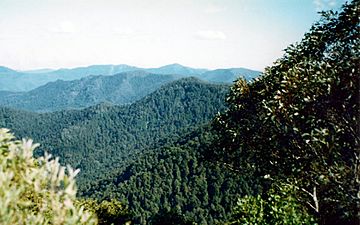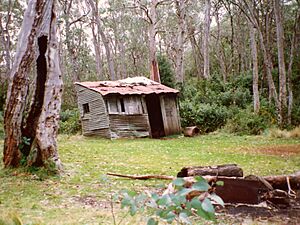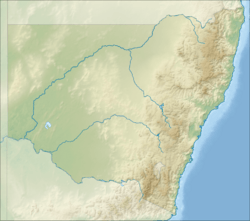Careys Peak facts for kids
Quick facts for kids Careys Peak |
|
|---|---|

View from Careys Peak
|
|
| Highest point | |
| Elevation | 1,544 m (5,066 ft) |
| Geography | |
| Location | Barrington Tops National Park, New South Wales, Australia |
| Parent range | Williams Range, Mount Royal Range |
| Geology | |
| Age of rock | Eocene |
| Mountain type | Alkali Gabbro |
Careys Peak is a tall mountain peak in New South Wales, Australia. It's part of the Williams Range, which is in the Mount Royal Range. This mountain is found in the Upper Hunter area.
It stands at 1,544 meters (about 5,066 feet) above sea level. This makes it one of the highest points in Barrington Tops National Park. The park is located about 200 kilometers (124 miles) north of Sydney.
Careys Peak sits on the edge of the Barrington Tops plateau. This area is a declared wilderness and part of the World Heritage Gondwana Rainforests of Australia. Rivers like the Allyn River and Williams River start nearby.
On a clear day, you might see the high peaks of the Blue Mountains. If you look southeast, you can even spot the sandy Stockton Beach on the coast. People love the beautiful views here. The thick rainforests and snow gum trees make the wilderness very special.
Careys Peak is a popular spot for camping and bushwalking. Long ago, there was even a skiing slope behind the peak. But nature has taken over, and the slope is now covered by new bush growth.
What's in a Name?
Careys Peak got its name from a local drover. A drover is someone who moves cattle. In 1839, about 500 cattle were brought to Barrington Tops. This happened during a time when there wasn't much rain.
But then, it snowed for 21 days that winter! All the cattle died, and the drover's tents blew away. The drover, whose last name was Carey, had a clever idea. He suggested using the cattle hides to build a shelter. That's how the peak got its name.
Rocks and How They Formed
The rocks around Careys Peak are mostly a type called Alkali Gabbro. This is a kind of igneous rock. Igneous rocks form when hot, melted rock cools down.
Careys Peak was once a vent of the Barrington Volcano. During the Eocene Period, a very long time ago, a huge flow of basalt rock covered most of the nearby plateau. Below these younger rocks, you can find older ones. These include Permian Granodiorites and Devonian-Carboniferous sedimentary rocks. Sedimentary rocks form from layers of mud, sand, or other materials. Examples here are mudstones, siltstones, and some conglomerates and limestones.
Plants and Trees

The area around Careys Peak is full of trees. On the high plateau, you'll find alpine woodland. This means trees that grow in cold, mountain areas.
On the steep slopes, there's a cool temperate rainforest. The most common tree here is the Antarctic beech. Other interesting plants nearby include the snow gum, southern sassafras, and broad-leaved pepperbush.
In 1978, a large landslip happened in the rainforest at Careys Peak. This area is now slowly growing back naturally. At first, different kinds of plants grew there. But over time, it is expected to return to being an Antarctic beech rainforest.
Animals You Might See
Many animals live in this area. You might spot wombats, eastern quolls, pademelons, eastern grey kangaroos, and swamp wallabies.
If you look closely in the bushes, you might see Lyrebirds. These birds are known for their amazing ability to copy sounds. High above, you'll often hear and see yellow-tailed black cockatoos flying.


